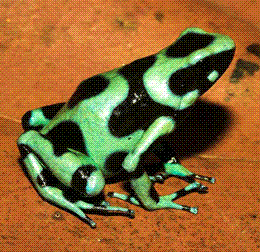 Green and Black Poison Dart Frog Green and Black Poison Dart FrogDendrobates auratus
Description
This frog is 1.5 to 2 inches
long. Most individuals are green and black, but
some populations are light blue or brownish and
black; the black can be in either spots or bands.
The common name comes from the fact that these
frogs have poison glands throughout the surface
of their bodies, something which is advertised to
predators with color vision by means of the
bright colors.
Distribution and
Habitat
Dendrobates auratus is
found from Nicaragua and Costa Rica to
southeastern Brazil and Bolivia, and has also
been introduced into Hawaii. It is typically
found on the floor of rain forests near small
streams or pools, but in Hawaii it can also be
seen near urban areas that have water pools
available for egg-laying and tadpole development.
Feeding
Adult poison dart frogs feed on
spiders and small insects. Part of their native
diet includes a genus of ants that have high
quantities of alkaloids in their tissues, and
those alkaloids are what produce the poison
secreted by the frogs; if fed a diet that does
not include those ants no poison is produced.
Prey is captured with a sticky, retractible
tongue. Tadpoles feed on arthropod larvae, and,
on occasion, other tadpoles.
Reproduction
Mating usually occurs during
the rainy season, which runs from July to
September. Males fight each other for territorial
rights. Once a male has established his territory
he will begin calling for potential mates. After
mating the female will deposit up to six eggs in
a small pool (in Hawaii they may even lay them in
discarded cans or bottles) and then go on her
way. The eggs are looked after by the male during
the two-week incubation period, after which he
carries the tadpoles to a suitable place for
further development and then leaves them.
Tadpoles will take another six weeks to reach
adulthood.
Other Behavior
The green and black poison dart
frog is diurnal, but is most active during the
day.
Scientific
Classification
phylum Chordata
subphylum Vertebrata
class
Amphibia
order
Anura
family Dendrobatidae
genus & species Dendrobates auratus

Animal Diversity Web http://animaldiversity.org/accounts/Dendrobates_auratus/
Questions or comments about
this page?
|



